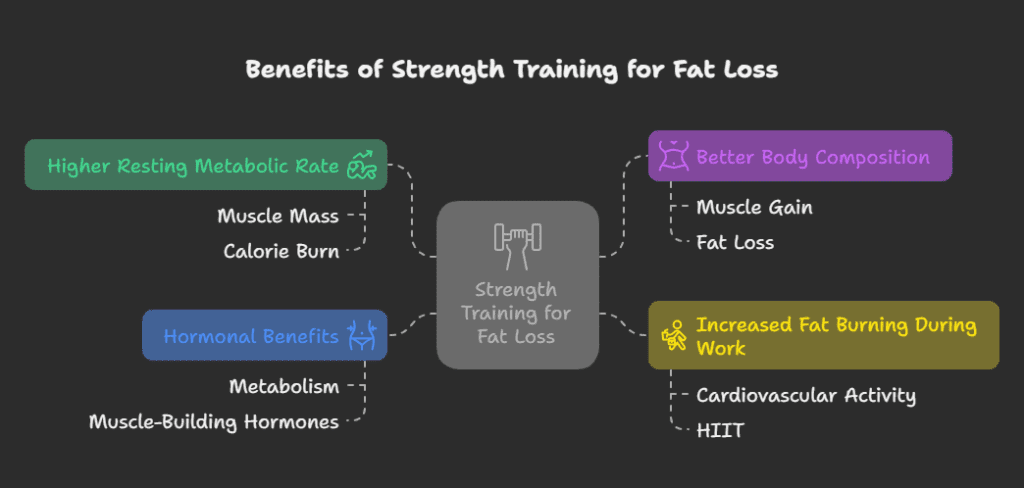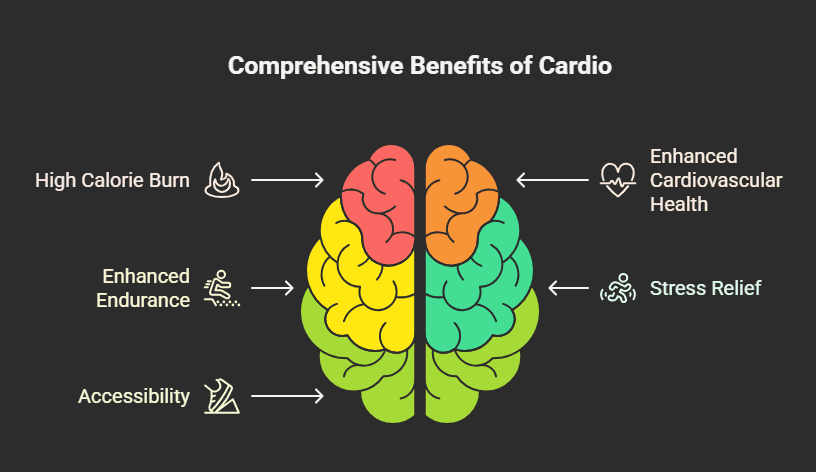Let’s face it, working with recalcitrant belly fat is a universal frustration. Most of us fantasize about a slimmer midsection and find ourselves resorting to repeated crunches in hopes of somehow magically burning off that bulge. You’ve no doubt searched “exercises for belly fat” repeatedly, praying for that one little trick. And here’s the reality: the fitness market doesn’t always scream from the rooftops: you simply can’t spot-reduce fat. Performing hundreds of crunches may tone your abdominal muscles (good thing!), but it will not target burning the layer of fat covering them. So if crunches aren’t the solution,
what is? How do you lose belly fat?
The secret is in learning how fat loss works and targeting exercises and strategies that stimulate overall body fat loss. When your overall body fat percentage goes down, your belly fat will go down with it.
This ultimate guide will break the myth of spot reduction and take you through the best strategies. We will explore in depth the powerhouse mix of compound exercises, High-Intensity Interval Training (HIIT), regular cardio, and intelligent strength training techniques that are meant to transform your body into a leaner, fat-burning machine. Prepare to learn the actual exercises for belly fat that work, taking you towards a stronger core and a healthier you.
The Myth of Spot Reduction: Why Crunches Won’t Flatten Your Stomach Alone
It makes sense, doesn’t it? Exercise the muscles in the region you want to lose fat from, and the fat just melts away. Not quite, unfortunately. Our bodies don’t function that way. Fat loss is a systemic phenomenon, which means your body chooses where it draws energy (fat) from depending on genetics, hormones, and total energy balance, not depending on what muscles you’re training at any given moment.
Consider this: when you take money out of your bank account, you can’t ask the bank to take only bills that were deposited from a particular deposit.
The bank pays you from the overall pool. Likewise, when your body requires energy when you exercise or due to being in a calorie deficit, it uses fat from storage depots throughout your body. Others tend to store fat in their hips, thighs, or belly, and these may be the last places to lose weight.
- What Crunches Do Achieve: Crunches and other conventional ab exercises do develop and strengthen the rectus abdominis (the “six-pack” muscles), obliques (side abs), and transverse abdominis (deep core muscle). A strong core is great for posture, stability, avoiding back pain, and enhancing athletic performance.
- What Crunches Don’t Do: They don’t torch a large quantity of calories like larger, multi-joint exercises. They don’t specifically address the subcutaneous (below the skin) or visceral (around the organs) fat in your stomach area
.Thus, while including core exercises for a flat stomach can be helpful to develop muscle definition beneath the fat and enhance core strength, they are not the main culprits behind losing belly fat. You require mechanisms that burn additional calories and enhance your metabolism.
The Winning Strategy: Total Fat Loss Through Calorie Expenditure
To burn fat from anywhere on your body, including your stomach, you must be in a state of caloric deficit at all times. That is, burn more calories than you take in. Exercise contributes hugely to the “calories burned” end of this calculation.
The best exercises for burning calories and supporting fat loss are those that:
- Engage Multiple Large Muscle Groups: Exercising larger muscles (such as legs and back) takes more energy.
- Elevate Your Heart Rate Significantly: This shows a higher intensity and more calorie burn during exercise.
- Boost Your Metabolism: Certain types of exercise can keep your metabolism boosted even after you stop exercising.
This is where compound exercises, HIIT, strength training, and cardio fit in. Let’s dissect each element.
HIIT for Belly Fat: The Metabolic Powerhouse
High-Intensity Interval Training (HIIT) is a training method in which you provide maximum, one hundred percent effort in brief, intense bursts of exercise, followed by brief, sometimes active, periods of recovery. This kind of training raises and maintains your heart rate and burns more fat in a shorter time.
1. Why HIIT Works for Fat Loss:
- High Calorie Burn: You are expending a high number of calories during a brief HIIT workout (usually 15-30 minutes).
- EPOC (Excess Post-exercise Oxygen Consumption): This is the “afterburn effect.” Following an intense HIIT workout, your body requires additional oxygen to recover and return to a resting state. Recovery takes energy, so you continue to burn excess calories for hours after your workout is complete. Research indicates HIIT can cause a larger EPOC effect than steady-state cardio.
- Improved Insulin Sensitivity: HIIT can help improve how your body uses insulin, which is important for managing blood sugar and can influence fat storage.
- Time Efficiency: Get a powerful workout done in a fraction of the time compared to longer, slower cardio sessions
2. Effective HIIT Exercises (Examples):
- Burpees: A full-body exercise combining a squat, push-up, and jump. It’s tough but incredibly effective.
- Mountain Climbers: A dynamic plank variation that engages the core, shoulders, and legs while driving up your heart rate.
- High Knees: Running in place while bringing your knees up as high as possible towards your chest.
- Jump Squats: An explosive version of the squat that builds power and burns serious calories.
- Jumping Lunges: An advanced lunge variation adding a plyometric element.
- Battle Ropes: When possible, using battle ropes offers a high-intensity upper body and core training.
- Kettlebell Swings: A heavy hip-hinge motion that targets the posterior chain and sends heart rate skyward.
3. Example of HIIT Workout Structure:
- Warm-up: 5 minutes of light cardio and dynamic stretching.
- Workout: Select 4-5 exercises. Do each exercise as hard as possible for 30-45 seconds, rest or move at low intensity for 15-30 seconds (such as in-place walking). Do the whole circuit 3-5 times.
- Cool-down: 5 minutes of stretching.
Key Note: HIIT is not for the faint of heart. Begin slowly (perhaps 1-2 times per week) and give your body sufficient time to recover between sessions. Listen to your body and adjust exercises accordingly. A fitness professional should always be consulted, particularly if you’re new to exercise or have health issues. Applying HIIT to lose belly fat is a powerful approach, but it must be done in the right manner.
Strength Training to Burn Belly Fat: Create Muscle, Burn Additional Calories
While cardio and HIIT reign as calorie-burning kings during the session and shortly afterwards, strength training has a one-of-a-kind long-term fat-loss benefit. Gaining lean muscle mass drastically alters your metabolism.
1. Why Strength Training Contributes to Fat Loss

- Higher Resting Metabolic Rate (RMR): Muscle tissue is more metabolically active than fat tissue. This translates to the fact that the greater your muscle mass, the greater the number of calories your body burns at rest, 24/7. Even when you’re sleeping or sitting at your desk, greater muscle mass allows you to burn more calories.
- Better Body Composition: Strength training tones your body by adding muscle and decreasing fat, creating a lean, toned appearance (and the abdominal region as well, once the fat is removed).
- Increased Fat Burning During Work: Harder muscles can work longer and harder during all forms of activity, including cardiovascular and HIIT, resulting in higher overall caloric expenditure.
- Hormonal Benefits: Strength training can benefit fat metabolism and muscle-building hormones.
2. Prioritize Compound Exercises:
These are multi-joint exercises that target multiple muscle groups at once. They are much more effective for building total strength and burning calories than isolation exercises (such as bicep curls). Make these your top priority in your strength training belly fat loss program:

- Squats (Barbell, Dumbbell, Goblet): Engages quads, glutes, hamstrings, core, and back. King of lower body exercise.
- Deadlifts (Conventional, Romanian, Sumo): Nearing every muscle in the human body, mainly the posterior chain (back, glutes, hamstrings) and core. Amazing fat burner and strength developer.
- Lunges (Walking, Static, Reverse): Engages quads, glutes, and hamstrings, while engaging balance and stability in the core.
- Push-ups (alternating variations: Incline/Knee Push-ups): Engages chest, shoulders, triceps, and core.
- Rows (Dumbbell Rows, Barbell Rows, Cable Rows): Activates the muscles of the back (lats, rhomboids, traps) as well as the biceps. Posture vital.
- Overhead Press (Barbell or Dumbbell): Targets shoulders, triceps, and core strength
Organizing Your Strength Training
- Shoot for 2-4 strength workouts a week, training all your main muscle groups.
- Focus on progressive overload: gradually increasing the weight, reps, or sets over time to continually challenge your muscles.
- Include a mix of compound and some isolation exercises if desired.
- Ensure proper form to prevent injury. Consider hiring a coach for initial guidance.
Remember, the goal of strength training for belly fat isn’t just about lifting heavy; it’s about building functional muscle that boosts your metabolism long-term.
The Unsung Hero: Steady Cardio for Belly Fat
Although HIIT is given a lot of credit for being so intense, old-school steady-state cardio continues to play a crucial role in any successful plan for fat loss.
What Is Steady-State Cardio? It’s doing aerobic exercise at moderate intensity (being able to chat but not hold a song and dance comfortably) for an extended duration (generally 30+ minutes).
Benefits of Cardio for Fat Loss:

- High Calorie Burn: Long cardio workouts burn a lot of calories, which directly adds to your caloric deficit.
- Enhanced Cardiovascular Health: Pumps up your heart and lungs, improves blood flow, and reduces blood pressure.
- Enhanced Endurance: Enables you to maintain activity for longer periods, both during exercise and in day-to-day life.
- Stress Relief: Oftentimes, people find activities such as jogging or cycling to be meditative and useful for stress management (which affects belly fat through cortisol).
- Accessibility: Most types of cardio use little equipment (running, brisk walking).
Good Cardio Choices:
- Brisk Walking: Very accessible, low-impact, and effective, particularly when performed regularly and at a decent pace.
- Running/Jogging: Old-school high-impact calorie burner.
- Cycling (Outdoor or Stationary): Great low-impact choice, excellent for leg strength.
- Swimming: Full-body, non-impact exercise that’s easy on the joints.
- Elliptical Trainer: Simulates running with less impact.
- Rowing Machine: Gives an amazing full-body strength and cardio exercise.
- Dancing: An Energetic and enjoyable method for raising your heart rate.
Finding the Right Balance: A good strategy is often a combination of both HIIT and steady-state cardio for belly fat control. For instance, 1-2 HIIT sessions and 2-3 moderate-intensity cardio sessions per week, in addition to strength training. Consistency is the key. Choose activities you like so you’ll maintain them in the long run.
Revisiting the Core: Smart Core Exercises for a Flat Stomach (Appearance)
Now that we’ve covered how to burn the fat layer over your belly, let’s discuss building the muscles beneath. Although not fat burners per se, certain core exercises for a flat stomach are essential once the fat layer begins to decrease. A strong, defined core helps with
- Better Posture: Makes you stand taller, immediately making your midsection appear leaner.
- A Tighter “Corset”: Strengthening the deep transverse abdominis acts like an internal weight belt, helping to pull everything in.
- Stability and Injury Prevention: A strong core supports your spine during everyday movements and heavy lifting.
- Enhanced Definition: Once body fat is low enough, strong abdominal muscles will be visible.
- Effective Core Exercises (Beyond Crunches):
- Plank: The ultimate core stabilizer. Engages the entire core musculature isometrically. Variations: side planks, forearm planks, plank jacks.
- Bird Dog: Great for core stability, balance, and activation of the deep core muscles without putting stress on the lower back.
- Leg Raises (Lying or Hanging): More effectively targets the lower abdominal area than crunches. Make sure your lower back remains pressed into the ground (if lying).
- Russian Twists (Weighted or Unweighted): Targets obliques for rotational strength. Concentrate on deliberate torso rotation, not merely moving your arms.
- Dead Bug: Like the Bird Dog but done lying on your back, excellent for controlling opposite limbs while maintaining a stable core.
- Pallof Press: Anti-rotation exercise with cable machine or resistance band, great for core stability.
- Ab Wheel Rollouts: An advanced exercise that strongly engages the entire core.
Include 2-3 core-specific sessions within your weekly training, or toss a few core exercises onto the end of your strength or cardio training. Prioritize quality reps and form over quantity.
Putting It All Together: Creating Your Lose Belly Fat Workout Plan
So, how do you put all these pieces together into a good lose belly fat workout routine? There’s no one-size-fits-all perfect plan since it would vary with your fitness level, interests, and time availability. But here’s a balanced way of doing things, maybe:
Weekly Schedule Example:
- Monday: Full Body Strength Training (compound lifts) + 10 min Core Work
- Tuesday: HIIT Session (20-25 minutes)
- Wednesday: Active Recovery (light walk, stretch, yoga) or Rest
- Thursday: Strength Training for Upper Body + 10 min Core
- Friday: Steady-State Cardio (30-45 minutes – e.g., cycling, jogging)
- Saturday: Lower Body Strength Training OR alternative HIIT session
- Sunday: Rest or light exercise such as walking.
Principles for Success:
- Consistency: Following your plan week in and week out is more crucial than having the occasional “perfect” workout.
- Progression: Progressively increase the difficulty of your workouts (increase weight, duration, intensity, or reps/sets).
- Listen to Your Body: Have rest days and do not push through sudden pain. Recovery is when your body is adapting and building stronger.
- Enjoyment: Try doing things you enjoy to promote adherence.
- Proper Form: Keep correct form, completing work at the expense of speed or weight to maximize effectiveness and lower the chance of injury.
Beyond Exercise: The Crucial Role of Nutrition and Lifestyle
It’s not possible to discuss losing belly fat without referring to nutrition and lifestyle considerations. You can have the greatest workout plan in the world, but if your diet isn’t in harmony with your goals, you won’t make progress, or it will be slow. Keep the “calories in vs. calories out” equation in mind.
Nutrition:
- Calorie Deficit: Eat slightly fewer calories than you expend.
- Prioritize Protein: Aids in maintaining muscle mass while losing fat and encourages fullness.
- Focus on Whole Foods: Fruits, vegetables, lean proteins, whole grains, and healthy fats provide essential nutrients and fiber.
- Limit Processed Foods, Sugary Drinks, and Excessive Alcohol: These often contribute empty calories and can hinder fat loss.
- Stay Hydrated: Drink plenty of water throughout the day.
Lifestyle:
- Adequate Sleep: Target 7-9 hours of good sleep at night. Insufficient sleep can interfere with hormones (such as cortisol and ghrelin) that regulate hunger and fat storage, especially around the stomach.
- Stress Management: Stress in the long term raises cortisol, a hormone associated with greater storage of abdominal fat. Discover positive ways to handle stress, like meditation, yoga, walking outdoors, or hobbies.
Conclusion: The Sustainable Path to a Flatter Stomach
Belly fat loss isn’t about discovering one miracle exercise or crunching yourself into oblivion. It’s about embracing an entire system based on total body fat loss. The best exercises to burn belly fat are ones that burn high levels of calories, create metabolism-boosting muscle, and enhance your cardiovascular fitness








